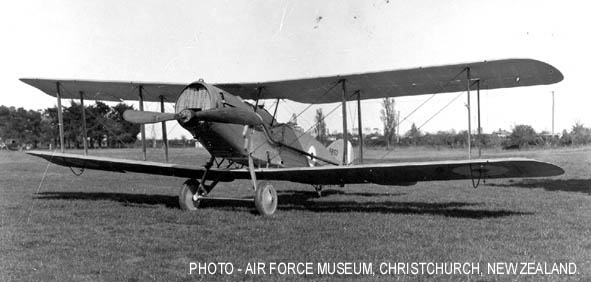
NZDF-SERIALS
Australian
& New Zealand Military Aircraft Serials & History
RNZAF
Bristol
F.2b Fighter
H1557 & H1558, 6856 & 6857, & 7120 to 7122

Powered
by FreeFind
Site search
Web search
Hosted by:
Integrity Technical
Solutions
| Serial | c/n | Type | Aircraft history |
| H1557 | 5274 | F.2b | Arrived in Christchurch aboard "SS
Matatua" on 27 August 1919 as Imperial Gift aircraft. Retained in crates at Christchurch and erected at Wigram in early 1925 and took part in the 1925 NZPAF Refreshed Course. Crashed at Christchurch on Wednesday 17 March 1926 during the annual NZPAF Refresher Course at Wigram. The aircraft was performing aerobatics at 2000 feet over Papanui when it entered a left hand spin and crashed into a property in Harewood Road. The pilot Captain Frederick Horrell and a passenger Lewis Reid were killed, and the officer under instruction, Leiutenant P. Turner was seriously injured. Horrell was the first military flying death in New Zealand. |
| H1558 | 5275 | F.2b | Arrived in Christchurch aboard "SS
Matatua" on 27 August 1919 as Imperial Gift aircraft. First flight in New Zealand on 04 September 1919. Used during the first NZPAF Refresher Course at Wigram in February 1923 and also in following years. Badly damaged during the 1929 Refresher Course but later repaired. Further details not known but thought to have been scrapped during late 1930-early 1931. |
| 6856 | ? | F.2b Mk II | Departed England on "Suffolk" in
October 1925 after reconditioning as virtually new aircraft by
Bristol Aeroplane Company. Withdrawn from service at Wigram and converted to instructional airframe at TTS Wigram in about November 1936. One of these aircraft was later sent from the TTS to the Palmerston North Technical College and another to the Wellington Aero Club. The Wigram instructional airframes are believed to have been burnt about the time of the outbreak of war in 1939. |
| 6857 | ? | F.2b Mk II | Departed England on "Suffolk" in
October 1925 after reconditioning as virtually new aircraft by
Bristol Aeroplane Company. Withdrawn from service at Wigram and converted to instructional airframe at TTS Wigram in about November 1936. One of these aircraft was later sent from the TTS to the Palmerston North Technical College and another to the Wellington Aero Club. The Wigram instructional airframes are believed to have been burnt about the time of the outbreak of war in 1939. |
| 7120 | ? | F.2b Mk III Dual |
Arrived 1927. Withdrawn from service at Wigram and converted to instructional airframe at TTS Wigram in about November 1936. One of these aircraft was later sent from the TTS to the Palmerston North Technical College and another to the Wellington Aero Club. The Wigram instructional airframes are believed to have been burnt about the time of the outbreak of war in 1939. |
| 7121 | ? | F.2b Mk III (J type) |
Air tested in England on 06 May 1927
prior to shipment to New Zealand. Received at Wigram on 03 August 1927. Crashed at Lake Ellesmore during NZPAF Refresher Course at Wigram on 25 February 1936. The aircraft dived toward the target on a bombing range but failed to pull out and somersaulted several times after hitting the ground. The pilot Flying Officer Graham Owen died some hours later in hospital. Total flying time until the accident was 669.15 hours. |
| 7122 | ? | F.2b Mk III (J type) |
Received at Wigram in August 1927.
Withdrawn from service at Wigram and converted to instructional airframe at TTS Wigram in about November 1936. One of these aircraft was later sent from the TTS to the Palmerston North Technical College and another to the Wellington Aero Club. The Wigram instructional airframes are believed to have been burnt about the time of the outbreak of war in 1939. |
Author: Ivan Prince (Updated by Brendan Cowan)
Sources: AHSNZ publications 1965-1974. AHSNZ Journal December 1989. NZ Wings August 1982. "For Your Tomorrow" by Errol Martyn.
Emails: Martin Edwards, Brendan Cowan,
Updated 29 October 2013
It
is our policy to only show historical events, no
current operational information will be displayed
on this website.
"The ADF-Serials & NZDF-Serials
team give permission to use the content of this
page, excluding images, providing that it
contains an acknowledgement to the adf-serials
team and any other listed sources."
![]()